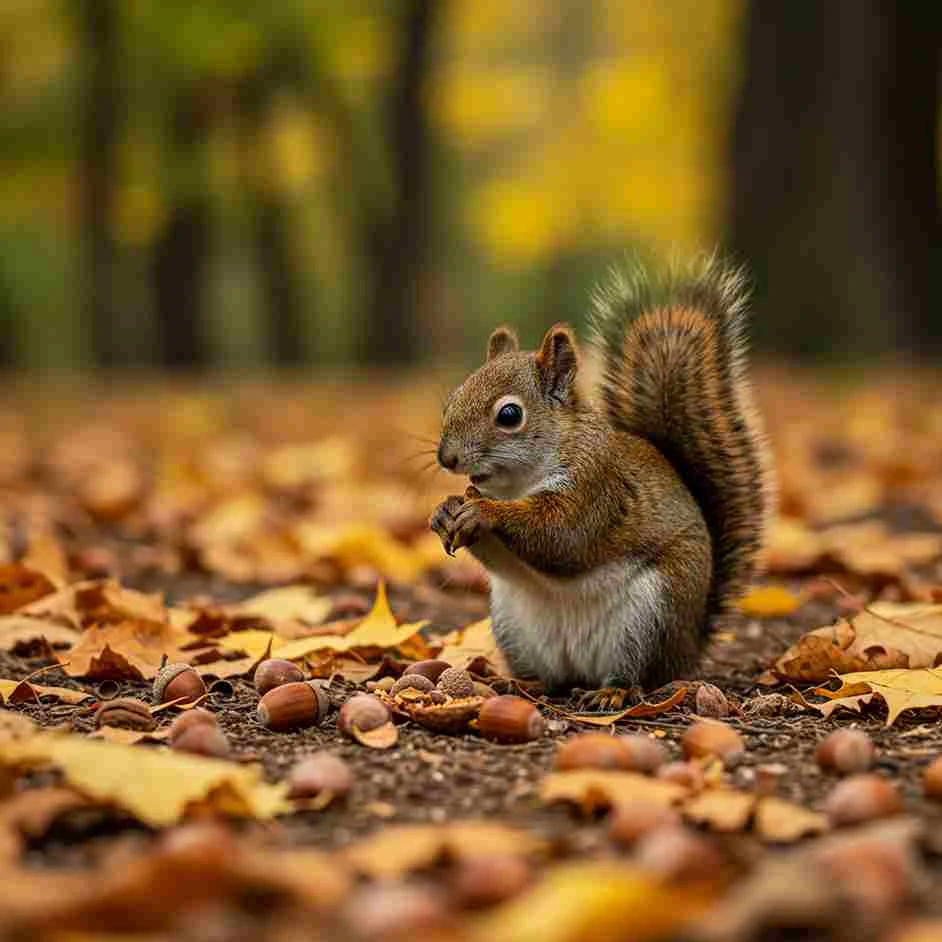What do squirrels eat in the winter when food seems scarce and the landscape is covered with snow? These resourceful rodents have developed fascinating strategies to ensure they don’t go hungry during the coldest months. If you love to get to know about what different animals and insects eat, take a look at the following:
What Do They has prepared this blog so you’ll learn the answer to what do squirrels eat in the winter, their preparation techniques, and how their dietary habits change to help them survive until spring.
How Squirrels Prepare for Winter

Unlike some animals that hibernate throughout the cold season, most squirrels remain active during winter and need regular nutrition. They prepare for winter food scarcity through:
- Caching: Storing food in numerous locations
- Body fat: Building reserves during fall
- Behavioral adaptations: Reducing activity during extreme cold
Primary Winter Food Sources for Squirrels

Cached Foods
What do squirrels eat in the winter months when fresh food is unavailable? Their primary food source comes from items they’ve hidden during autumn:
- Acorns
- Walnuts
- Hickory nuts
- Pecans
- Pine nuts
- Hazelnuts
- Beechnuts
- Seeds
Amazingly, a single gray squirrel can create several thousand caches each autumn, storing enough food to last through winter.
Tree Bark and Buds
When cached supplies run low, squirrels turn to trees for sustenance:
- Inner bark (cambium layer)
- Tree buds
- Maple tree sap
- Pine cone seeds
- Conifer needles
Persistent Fruits and Berries
Some fruits remain available through winter:
- Rose hips
- Crabapples
- Mountain ash berries
- Bittersweet
- Dried wild berries
Human-Provided Food Sources
In suburban and urban environments, what do squirrels eat in the winter often includes:
- Bird feeder contents
- Discarded human food
- Intentionally provided nuts and seeds
- Pet food left outdoors
- Compost pile findings
Differences Between Squirrel Species
What do squirrels eat in the winter varies by species:
Gray and Fox Squirrels
- Rely heavily on buried nuts and seeds
- More likely to raid bird feeders
- May eat tree buds when desperate
Red Squirrels
- Create central caches called “middens”
- Focus on conifer seeds
- Often store mushrooms during fall
- More likely to eat tree bark in winter
Flying Squirrels
- More carnivorous in winter
- May consume insects, eggs, and carrion
- Often raid bird nests
- Will visit bird feeders at night
Ground Squirrels
- Most species hibernate
- Wake occasionally to eat from food chambers
- Store food in underground burrows rather than scattered caches
Squirrel Caching Techniques

The success of winter survival depends largely on fall preparation:
Scatter Hoarding
- Burying individual items in many locations
- Typically used by tree squirrels
- Helps prevent total loss to competitors
- Relies on memory and smell for retrieval
Larder Hoarding
- Creating central food stockpiles
- Used primarily by red squirrels
- Requires defense against theft
- More efficient for retrieval
Memory and Food Finding
A fascinating aspect of what do squirrels eat in the winter is how they relocate their food:
- Can remember thousands of cache locations
- Use spatial memory mapped to landmarks
- Employ their acute sense of smell
- May detect buried nuts under a foot of snow
- Sometimes find caches made by other squirrels
Regional Variations in Winter Diet
What squirrels eat in the winter varies significantly by region:
Northern Climates
- Heavier reliance on cached nuts and seeds
- More conifer seeds in the diet
- Higher fat content foods preferred
Southern Regions
- More fresh plant material available year-round
- Less reliance on stored food
- More consistent diet across seasons
Urban vs. Rural
- Urban squirrels often rely more on bird feeders
- Rural squirrels consume more natural foods
- Suburban squirrels may have the most varied diet
Nutritional Challenges of Winter
Winter creates several dietary challenges, hence a valid question of what do squirrels eat in the winter. The following are some nutritional challenges that squirrels might face:
- Higher calorie needs in cold weather
- Limited food diversity
- Potential depletion of caches
- Competition from other wildlife
- Difficulty accessing food under snow and ice
How to Help Squirrels in Winter

If you’re concerned about what do squirrels eat in the winter in your area, you can help by:
- Providing nuts with shells (unsalted)
- Offering corn on the cob
- Setting up dedicated squirrel feeders
- Leaving out fresh water
- Planting nut-bearing trees for long-term support
Foods to Avoid Giving Squirrels
Not all human foods are safe:
- Salted or seasoned nuts
- Processed foods
- Chocolate
- Junk food
- Bread (minimal nutritional value)
Signs of Winter Food Stress in Squirrels
You can identify if squirrels are struggling to find food by observing:
- Visible weight loss
- Increased daytime activity during very cold weather
- Unusual aggression at food sources
- Excessive bark stripping from trees
- Frequent raids on bird feeders
So the Answer to What do Squirrels Eat in the Winter is…
As we’ve explored what do squirrels eat in the winter, these resourceful animals rely on a combination of carefully stored caches, tree materials, persistent wild fruits, and sometimes human-provided foods to survive the challenging winter months. Their remarkable memory for cache locations and ability to adapt their diet to whatever resources are available demonstrate why squirrels are such successful creatures.
Understanding the winter diet of squirrels gives us insight into their behavior and the important role they play in forest ecosystems, including tree propagation through forgotten buried nuts. Whether you’re a wildlife enthusiast or simply curious about the squirrels in your backyard, knowing what these clever animals eat during winter helps us appreciate their remarkable survival strategies during the harshest season of the year.








2 Comments